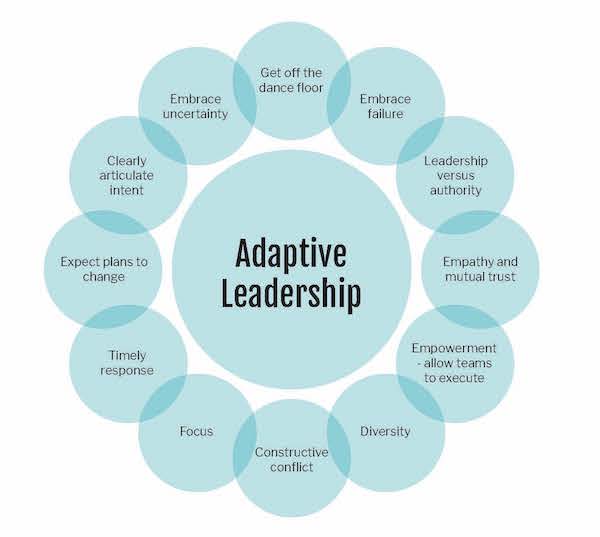In my last series of blogs, I explored the “Give It Up” model whereby true leaders need to move from a command and control style of leadership and towards one of delegation and trust.
Not only do leaders need to give up control, they need to become adaptive leaders and be able to chart a course when they cannot predict the outcome of their choices.
My Adaptive Leadership Model below illustrates what a leader has to undertake to become an adaptive leader.

Clearly articulate intent
Adaptive leaders, while avoiding command and control management or micromanagement of employees, must ensure that the strategic intent and objectives are clear.
The adaptive leader explains the ‘what’ not the ‘how’. Everyone must be aligned with a common goal and then left to achieve that goal in their own way. The goals must be clear and unambiguous but also credible and forceful. This should inspire action.
Adaptive leaders then keep their eye on the game but do not run on the pitch to direct and play the game.
Adaptive leadership provides direction using clearly articulated intent to enable actions to be taken in line with the intent. The purpose is to empower agile and adaptive leaders to achieve that intent. Intent is centralised and execution is distributed.
Embrace uncertainty
Adaptive leaders must embrace uncertainty and adopt new tactics if they play to win in the face of constant and relentless change.
Leaders must lead with uncertainty and be honest about it at the same time. If leaders cannot embrace uncertainty and, therefore, display overconfidence in a particular outcome, which may not arise, employees will lose trust in their leader. They will also disengage.
Using overconfidence as a protector means leaders are likely to make risky and costly decisions.
Adaptive leaders represent the truth and share this with their teams. When there is uncertainty, it is shared. This demonstrates authentic leadership. Teams that work for adaptive leaders who openly communicate uncertainly and seek team input to address the challenge are more engaged and loyal to the organization. Teams know that we are living in a turbulent world so they will immediately see through an overly confident, all-knowing leader as a false reality.
When change is uncertain, ambiguous, and constant, the successful adaptive leader will lead the team through the confusion and admit to not having all the answers. They will then call on the collective knowledge of the team to address the uncertainty. This demonstration of vulnerability establishes a sense of trust and mutual respect.
Game score
Leadership in the face of volatile, uncertain, complex, and ambiguous change has to be adaptive.
Adaptive leaders need to know when to operate in the fray, and when to get off the field and watch from the sideline.
They will embrace losing a game as a learning opportunity and the team will bounce back ready to play the next game. They will have empathy and be able to walk in another’s shoes to understand their perspective. Players are inspired to be accountable and make decisions.
Adaptive leaders expect and embrace change. It is their reality. The teams they build are dynamic and embrace change, and they channel any uncertainty into positive outcomes through collaboration and communication.
Adaptive leaders clearly articulate their intent and then let the players get on with the game. The players will ultimately win or lose the game.
In my next series of posts, I will be exploring the characteristics of Adaptive Leadership Teams.
Article by channel:
Everything you need to know about Digital Transformation
The best articles, news and events direct to your inbox
Read more articles tagged: Featured, Leadership







